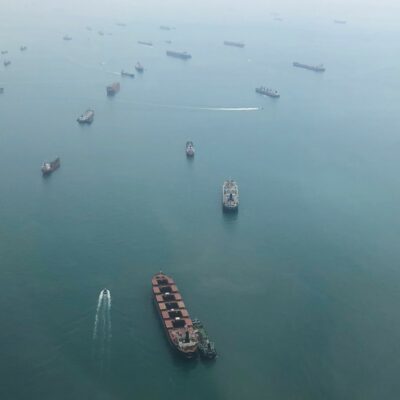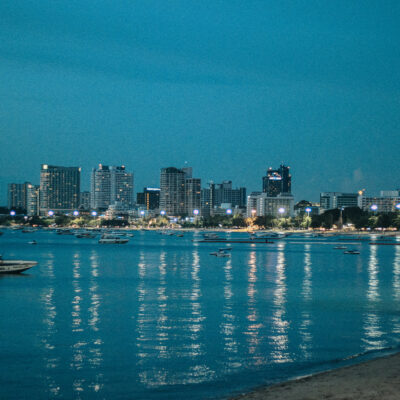The papers in this series Beyond the South China Sea: other maritime disputes in Southeast Asia have highlighted the persistence of ‘lesser-known’ maritime boundary disputes in Southeast Asia. Yet, they also reveal the efforts of regional states to resolve these disputes.
In 2022, Indonesia’s Foreign Minister Retno Marsudi stated that in the previous year, Indonesia had engaged in no less than 17 rounds of maritime boundary negotiations with the Philippines, Malaysia, Palau, and Vietnam. While the complex disputes of the South China Sea often serve to highlight the limits of maritime dispute resolution, 2022 ended with the welcome news that Indonesia and Vietnam had agreed to Exclusive Economic Zone (EEZ) boundaries in the waters surrounding the Natuna Islands after 12 years of bilateral negotiations. In numerous cases successful maritime boundary dispute resolution in the region has been due to bilateral negotiations, as Tharishini Krishnan’s paper in this series demonstrates, as well as an overall commitment to order and stability at sea.
Smaller powers, however, may use international public or collective diplomacy and legal mechanisms—such as international courts, arbitration tribunals, and conciliations—to defend maritime entitlements rather than relying on bilateral negotiations. Often described as the ‘constitution for the oceans’, the 1982 United Nations Convention on the Law of the Sea (UNCLOS) provides the overarching framework for these international maritime dispute resolution (IMDR) mechanisms. The New York University School of Law’s ‘Maritime Dispute Resolution Project’ recently found that such mechanisms have been used to resolve a multitude of maritime disputes all over the world.
In International Relations, the scholarship on why conflicts end or endure tends to diverge between material versus ideational understandings: for example, realists tend to focus on the role of material and strategic interests in driving or de-escalating disputes; liberals on the use of cooperative and multilateral mechanisms such as those encompassed by the UNCLOS regime; and constructivists on the role of national identity, ideas and norms in shaping state preferences and behaviour. Yet, understanding maritime dispute resolution requires a more nuanced framework that can elucidate the interplay between material and ideational factors. Our maritime dispute resolution framework focuses on three features: first, the type of dispute; second, power asymmetry and state identity; and third, the type of dispute resolution process and the ruling/decision. The use of this framework allows us to understand the material and ideational factors that contribute to dispute resolution and examine lessons from the use of dispute resolution processes in Southeast Asia and across the Indo-Pacific.
Types of maritime disputes
The type of maritime dispute can often affect the prospects for its successful resolution. There are three main variations of ‘maritime dispute’: disputes over the land features in a maritime area; disputes over the maritime jurisdiction; and ‘mixed’ disputes involving concurrent unresolved sovereignty and maritime entitlement issues.
UNCLOS was designed to resolve maritime disputes rather than deal with issues around sovereignty, which are handled by another set of international laws relating to territorial acquisition. There is a general principle of customary international law that is expressed as ‘land dominates the sea’—meaning that maritime rights are derived from recognition of a coastal states’ sovereignty. Although this principle is not uncontested, ambiguities about who possesses territory can often manifest into maritime disputes. Sovereignty disputes are subject to a distinctive body of international law governing the acquisition of territory, which includes principles such as effective occupation, cessation, and conquest. Mixed disputes call into question how the UNCLOS regime can establish maritime order in contexts where sovereignty is contested, but it also provides a way of comparing whether some types of disputes are easier to resolve than others.
The nature of the disputes can have ramifications for the success of dispute resolution mechanisms. Are mixed disputes with contested sovereignty elements more difficult to resolve than straight maritime disputes? Rhetoric around sovereignty can make it more difficult for states to back down as it can function as a narrative straitjacket.
Numerous states in Southeast Asia have familiarity with international law and arbitration processes, as initiators/and or defender to settle and resolve international maritime disputes. Of the 31 cases heard at the International Tribunal for the Law of the Sea, only one has been initiated by a Southeast Asian state (Malaysia vs Singapore). But maritime disputes have appeared in other courts, conciliations and arbitral tribunals. The one case heard by a United Nations Compulsory Commission was initiated by a Southeast Asian state—Timor-Leste. States from Southeast Asia have initiated a total of five International Court of Justice (ICJ) cases relevant to disputes over maritime area or land features: Malaysia (three cases against Singapore), Indonesia (one case against Malaysia), and Timor-Leste (one case against Australia). There has also been a number of maritime cases initiated under the auspices of the Permanent Court of Arbitration; Philippines initiated one against China in 2013, and Timor-Leste two proceedings against Australia, and Malaysia one against Singapore. In fact, almost all of the international legal cases initiated by Southeast Asian states have been in some way linked to maritime rights and land features. Regional states have used IMDRs in an effort to resolve mixed disputes, with mixed success. In July 2003, for example, Malaysia instituted proceedings in the International Tribunal for the Law of the Sea (ITLOS) against Singapore’s land reclamation activities, arguing that Singapore’s extension of the Tuas port impinged on its rights in and around the Straits of Johor, although it was unsuccessful in provisionally halting Singapore’s activities.
Probably the most famous use of an IMDR in this region was the Philippines initiating a case in 2013 against China’s claim to ‘historic rights’ in the South China Sea, which was heard by an arbitral tribunal constituted under UNCLOS. For its part, China did not participate in the Arbitral Tribunal on the grounds that it had legally excluded itself from compulsory arbitration of ‘disputes concerning maritime delimitation’ under Article 298 of UNCLOS. It also considered the Philippines’ ‘unilateral initiation’ of the arbitration as not meeting UNCLOS preconditions for such an initiation as there was no ‘real dispute between the parties’. Despite these objections, the tribunal found itself competent to hear the case.
The South China Sea disputes are particularly complicated due to the presence of multiple claimants of sovereignty and overlapping maritime jurisdictions. This is partly a consequence of geography, as the South China Sea is a semi-enclosed sea encompassing hundreds of small land features. Largely awarding in favour of the Philippines, the 2016 ruling sought to circumvent issues of sovereignty by classifying the land features as either rocks or low-lying elevations, which are not entitled to an exclusive economic zone (EEZ) or a continental shelf. In practical terms, however, the ‘success’ of this case is debatable: while it allowed extra-regional states such as the United States and Australia to criticise China’s excessive ‘nine-dash line’ claim in the South China Sea, it did little to change the material facts on the ground. Beijing did not participate in the case or respect the ruling, and instead used ‘lawfare’ strategies – such as the selective and incomplete application of legal concepts – to undermine the ruling. Two years after the ruling, in 2018, the Chinese Society of International Law produced an article of over 500 pages outlining what it viewed as the ‘many errors’ of the tribunal’s judgement. While the Philippines under President Rodrigo Duterte did not take advantage of the ruling, it has been presented by at least some regional states as a legitimate standard that China should obey. The Asia Maritime Transparency Initiative found that eight governments publicly called for the ruling to be respected (only one – the Philippines – from Southeast Asia), 35 issued generally positive statements (six from Southeast Asia), and only eight publicly rejected it (none from Southeast Asia).
There is also a history of Southeast Asian states using international courts beyond UNCLOS to solve maritime sovereignty issues. As the contributions by Jay Batongbacal and Leonardo Bernard in this series demonstrate, while sovereignty issues may be resolved, associated maritime boundary disputes can remain. In the 2002 case between Indonesia and Malaysia, the International Court of Justice (ICJ) concluded on the basis of effectivités that sovereignty over Pulau Ligitan and Pulau Sipadan belonged to Malaysia. While Indonesia did not officially protest the ruling, the maritime boundaries have remained unsettled, leading to protests in Indonesia in 2005 over oil and gas exploration in the Ambalat area and a military standoff between Malaysia and Indonesia.
The dispute between Singapore and Malaysia over the Pedra Branca land feature was also ‘mixed’, before the sovereignty dispute was resolved through international dispute resolution mechanisms. In 2008, the ICJ awarded Singapore sovereignty of Pedra Branca and Malaysia sovereignty of Middle Rock. This resolution of sovereignty has affected the prospects for maritime delimitation in the Strait of Singapore. As Bernard points out in his article, the negotiations for the Pedra Branca/Bintan segment of the Strait need to be tripartite between Indonesia, Singapore and Malaysia, especially given the presence of Middle Rock between Pedra Branca and Indonesia’s Bintan.
Power and identity
The relationship between power and identity of state parties matter, including their relative material capabilities, regime type and the international values they seek to project and protect. Identity informs a state’s self-understanding of who they represent, and what other states represent, which then informs their interests and actions. Leaders from smaller coastal and island states played pivotal roles in negotiating UNCLOS III in the 1970s and 1980s, and it is designed to ensure a fair and equitable distribution of maritime resources and jurisdiction irrespective of a state’s material capacities to defend them. In assessing maritime dispute resolution, one element to consider is the extent to which they are asymmetrical. One of the positive signs for Indo-Pacific dispute resolution is that smaller states have been able to ‘win’ disputes against larger powers. Yet, the bigger powers in a number of these successful disputes are generally not rising authoritarian powers, and tend to project their image as ‘maritime democracies’ that support the ‘rules-based order’.
In April 2016, Southeast Asian state Timor-Leste initiated the world’s first United Nations Compulsory Conciliation to resolve disputes with Australia over maritime boundaries and hydrocarbon reserves in the Timor Sea. At first reluctant to engage in international litigation, Canberra was compelled to change its stance. A maritime boundary treaty between Australia and Timor-Leste was signed in 2018 reflecting a shift in Australia’s foreign policy approach towards the Timor Sea.
As an ‘Indo-Pacific’ regional power, Australia had increasingly used ‘rules-based order’ narratives in its public diplomacy around China’s rejection of the South China Sea arbitration. This led to accusations of hypocrisy from supporters of Timor-Leste who argued that Australia was acting like China in avoiding maritime dispute resolution processes. Once the conciliation panel found itself competent to hear the case, Australia was compelled to participate in maritime boundary negotiations in good faith at least partly because it was concerned about the reputational costs of not doing so.
While relations between Myanmar and Bangladesh have been fractious at times, particularly due to the presence of Rohingya refugees in Bangladesh, the states were able to peacefully resolve a maritime boundary dispute in the Bay of Bengal through the use of the ITLOS mechanism, with a ruling handed down in March 2012. Both states were motivated primarily by material factors: settling the dispute could assist in attracting investment in hydrocarbon resource exploitation from corporations who may have been put off by the unsettled disputes. Both sides could also claim they had ‘won’ the case.
In another example beyond Southeast Asia but involving Bangladesh, an Arbitral Tribunal was initiated by Bangladesh in 2014 concerning its maritime boundary dispute with India in the Bay of Bengal, which is a complex concave maritime geography that also involved a long-running ownership dispute over New Moore/South Talpatti Island. The two parties had previously conducted eight failed rounds of bilateral negotiations between 1974 and 2008. Primarily a maritime dispute, the power asymmetry in bilateral negotiations favoured India, but Dhaka preferred an international arbitration in which it could advocate an ‘angle-bisector’ method of maritime delimitation. India did not protest the use of an arbitration.
There were three key strategic benefits for India in participating with the maritime dispute resolution process and ultimately accepting the Arbitral Tribunal’s ruling. First, its willing engagement in arbitration highlights India’s desire to develop its ‘role model’ credentials. India has historically sought to be a leader and role model for the world’s non-aligned countries of the so-called third world, or what New Delhi has now categorised as the ‘Global South’. Second, India’s international leadership in settling the dispute was contrasted against China’s ‘open contempt’ for the South China Sea Arbitration process in what appears to be starkly differing strategic narratives. This point would be compounded two years later when Beijing refused to accept the 2016 Permanent Court of Arbitration ruling in favour of the Philippines. Third, its engagement with the IMDR processes allowed India to promote itself as prioritising good relations with its neighbours, particularly in the economic development domain. These three factors ultimately help to promote its identity and interests as a regional leader.
Type of mechanism and decisions
As mentioned above, UNCLOS offers states a range of IMDR mechanisms, and the type of dispute resolution process often plays a part in whether maritime disputes are likely to be successful. One of the central issues with the South China Sea arbitration was the fact that China did not recognise the arbitral tribunal as holding competency in adjudicating maritime boundary issues. In 2006, China made a declaration under article 298 of UNCLOS that it does not accept the procedures provided for UNCLOS with respect to maritime boundary disputes. While the arbitral tribunal found itself competent, China continued to protest its legitimacy and ultimately rejected the 2016 ruling.
In some cases, arbitral proceedings may precede a negotiated settlement. While Malaysia was unsuccessful in persuading ITLOS that provisional measures be implemented in its 2003 case against Singapore in the Straits of Johor, in 2019, as Bernard makes clear, a breakthrough emerged when the two states bilaterally negotiated to suspend the expansions of their port limits.
In 2002, Australia also made a similar declaration to exclude disputes concerning maritime delimitation from compulsory arbitration. Australia had long preferred bilateral negotiation—in effect, meaning Timor-Leste could not take Australia to an international court or tribunal on delimitation matters. Although it also disputed the United Nations Compulsory Conciliation (UNCC) jurisdiction, Australia ultimately participated in good faith. Its participation was largely due to the way the UNCC functioned in practice: it ultimately acted as a scaffolded bilateral negotiation that would produce a non-binding result rather than a binding ruling. Negotiators were encouraged to creatively develop a maritime boundary that both Australia and Timor-Leste could accept. While this process can prove effective for a bilateral maritime dispute, it might be less successful for more complex disputes involving multiple parties.
By working through the process, Australia and Timor-Leste found a way to resolve the problems that had previously hindered prospects of an agreed maritime boundary. In particular, the boundary line they devised managed to avoid Indonesia becoming involved in the dispute, mainly due to Australia holding concerns about unravelling its continental shelf boundaries. Material interests were also important: Australia’s commercial interests had declined as the oil and gas in the Joint Petroleum Development Area in the Timor Sea dwindled. The changing strategic and economic circumstances provided a clear window for dispute resolution, although it is important to note that the issue around how to develop the lucrative Greater Sunrise gas field continues to be an issue in the bilateral relationship. It is important, therefore, to critically analyse the ‘wins’ and ‘material changes’ that manifest from maritime dispute resolution processes. While Timor-Leste won its hard-fought boundary this is yet to translate into tangible material benefits.
The Timor Case suggests that the nature of the ‘ruling’ can also influence whether or not (particularly respondent) states will accept the judgement. A key reason why states may avoid internationalising a dispute through dispute resolution mechanisms is that they fear they may lose what they claim, and, particularly in sovereignty disputes, potentially lose face with their domestic political audience. Therefore, encouraging ‘pragmatic’ and ‘flexible’ solutions may persuade both states in a bilateral dispute to accept the ruling if there is an element of ‘winning’ for both sides. Additionally, this may also encourage other states to resolve their disputes using international mechanisms. Conversely, a ruling that provides too much flexibility in interpretation may also mean that nothing much changes on the ground to progress dispute resolution.
These dynamics were also at play where the Arbitral Tribunal awarded nearly 80 percent of the disputed maritime area to Bangladesh. The ruling developed a creative solution by establishing a ‘grey area’ in which India holds EEZ rights to water column resources while Bangladesh holds extended continental shelf (seabed) rights. While Bangladesh appeared the winner in terms of maritime rights, India retained a ‘greater proportion of EEZ than Bangladesh relative to the ratio of their relevant coastlines, a standard measure of whether the delimitation of a maritime boundary is equitable’. The majority of the sea area surrounding South Talpatti/New Moore Island also went to India, and New Delhi could live with what it viewed as a ‘win-win’ ruling, even if the prevailing narrative was that Bangladesh had ‘won’ the overall dispute. Importantly in this case, the larger power India accepted the ruling due to the win-win nature of the decision.
While the use of a ‘grey area’ was a novel solution to a delimitation puzzle, it may also prove to be an ongoing area of continuing disagreement. Since the award was issued in 2014 by the tribunal, maritime disputes in the Bay of Bengal between Bangladesh and India have continued. One of the cases’ arbitrators, Dr. P Rao, foresaw future problems and said at the time, ‘The gray area may thus create more problems for the parties—who are now forced to co-habit the same area—than the benefits it could potentially offer.’ Nevertheless, the arbitration was lauded as an example of peaceful resolution of maritime disputes that upholds the international rule of law.
Conclusion
This paper has sought to build a maritime dispute resolution framework, which focuses on three fundamental features: recognition of the type of dispute; identification of power asymmetries; and the nature of mechanisms and the decisions that are made. Firstly, a recognition is need by states that the type of maritime dispute can often affect the prospects for its successful resolution. Second, the identities of states—and the projection of those identities in their international relations—matter for dispute resolution as do the power asymmetries between parties, which can work in diverse ways, producing diverse outcomes. Finally, states need to be aware of the types of dispute resolution process they use, because this often plays a part in whether maritime disputes are likely to be successful. Outside of the South China Sea disputes, there are numerous examples of successful maritime dispute resolution across the maritime domains of Asia and the Pacific, which underscore the successes of UNCLOS in allowing coastal states to defend their maritime interests, and may provide lessons for other ongoing disputes.
Authors: Associate Professor Bec Strating and Dr Troy Lee-Brown.
This article is part of the ‘Blue Security’ project led by La Trobe Asia, University of Western Australia Defence and Security Institute, Griffith Asia Institute, UNSW Canberra and the Asia-Pacific Development, Diplomacy and Defence Dialogue (AP4D). Views expressed are solely of its author/s and not representative of the Maritime Exchange, the Australian Government, or any collaboration partner country government.
Image: A boat off the coast of Bangladesh in the Bay of Bengal. Credit: Shakil Ahmed Sarowar/Wikimedia Commons.




